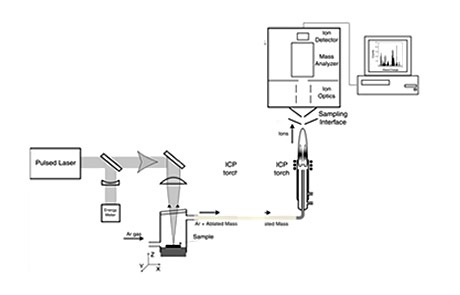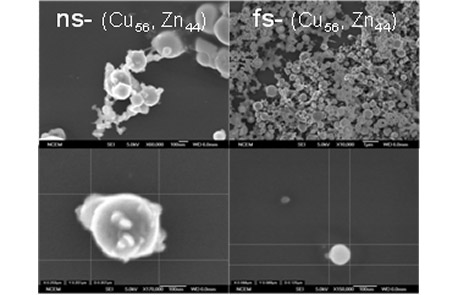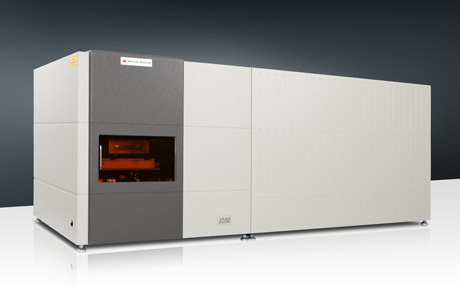LA-ICP-MS (Laser Ablation Inductively Coupled Plasma Mass Spectrometry) is a powerful analytical technology that enables highly sensitive elemental and isotopic analysis to be performed directly on solid samples.
LA-ICP-MS begins with a laser beam focused on the sample surface to generate fine particles – a process known as Laser Ablation. The ablated particles are then transported to the secondary excitation source of the ICP-MS instrument for digestion and ionization of the sampled mass. The excited ions in the plasma torch are subsequently introduced to a mass spectrometer detector for both elemental and isotopic analysis.

LA-ICP-MS diagram LA-ICP-MS Process – Laser ablation creates fine particles from the sample, which are then transported for rapid elemental and isotopic analysis.

Image of the laser ablation trench produced on three NIST glass standards (NIST 612, NIST 614 and NIST 616) during LA-ICP-MS trace element analysis (laser rastering speed = 10 mm/sec).

LA-ICP-MS craters Image of the 25 micron laser ablation craters in a 5 X 5 grid pattern on the glass surface and transient 27Al signal (20 sec laser pulses per sampled spot and 30 seconds between the spots)

Comparison of the ablated particle size using nanosecond laser pulse and femtosecond laser pulse for a brass alloy sample (56% Cu & 44% Zn).
Benefits of LA-ICP-MS
LA-ICP-MS is one of the most exciting analytical technologies available because it can perform ultra-highly sensitive chemical analysis down to ppb (parts per billion) level — without any sample preparation.
Samples can be both conducting or non-conducting, and the analysis can be performed in the air without the need for a complex vacuum system. Results are available within seconds; therefore LA-ICP-MS delivers that fastest analysis speed of all analytical techniques with the limit of detection approaching ppb level.
The sample mass size required for LA-ICP-MS analysis is sub-microscale — picograms to femtograms. Traditional liquid nebulization approaches for ICP-MS require the removal of milligrams of sample mass in order to be effective.
When applied with optimized laser ablation conditions and ICP-MS data acquisition protocols, LA-ICP-MS allows versatile solid sampling schemes that include:
- Bulk analysis
- Local inclusion and defect analysis
- Depth profiling
- Elemental/isotope mapping
The two most commonly used laser-based methods are bulk analysis with a typical laser spot size of 100 ~ 350μm and microanalysis with the laser spot size as small as a few microns.
Femtosecond Laser Pulsing
The use of femtosecond laser pulsing represents the latest technical advance in LA-ICP-MS technology. It improves precision and accuracy, reduces the elemental/isotopic fractionation, and enhances the sensitivity of the measurements. Many researches have shown that femtosecond laser pulsing brings these benefits to LA-ICP-MS analysis:
- Non-thermal mass ablation such as Coulomb explosion and direct chemical bond breaking that represents the true chemistry of the sample and is conducive in reducing the elemental/isotopic fractionation.
- An ideal size distribution (20 ~ 200 nm) of the ablated particles that are readily transported to the ICP-MS plasma torch that result in the increased detection sensitivity.
- More consistent size distribution of the ablated particles that decrease the fluctuations in the transient ICP-MS signal and increase the measurement precision.
- Complete digestion of the transported particles and reduction of fractionation in the secondary excitation source of the ICP-MS instrument.
Applied Spectra’s J200 Femtosecond LA Instrument

Comparison of the transient ICP-MS signal resulting from the femtosecond laser ablation (red) with respect to nanosecond laser ablation (black). The smaller and more consistent particle size distribution produces fewer fluctuations of the signal.

Applied Spectra’s J200 series LA-ICP-MS instrument
Applied Spectra harnesses LIBS technology with its state-of-the-art elemental testing devices. We deliver solutions that are fast, reliable, precise and environmentally friendly. Our instruments are adaptable to a variety of environments, from field testing, to manufacturing floors, to laboratory settings. Contact ASI’s technical sales staff to learn more.
[1] R.E. Russo, X.L. Mao, H.C. Liu, J.H. Yoo, S.S. Mao: Appl. Phys. A 69 [Suppl.], S887–S894 (1999)
